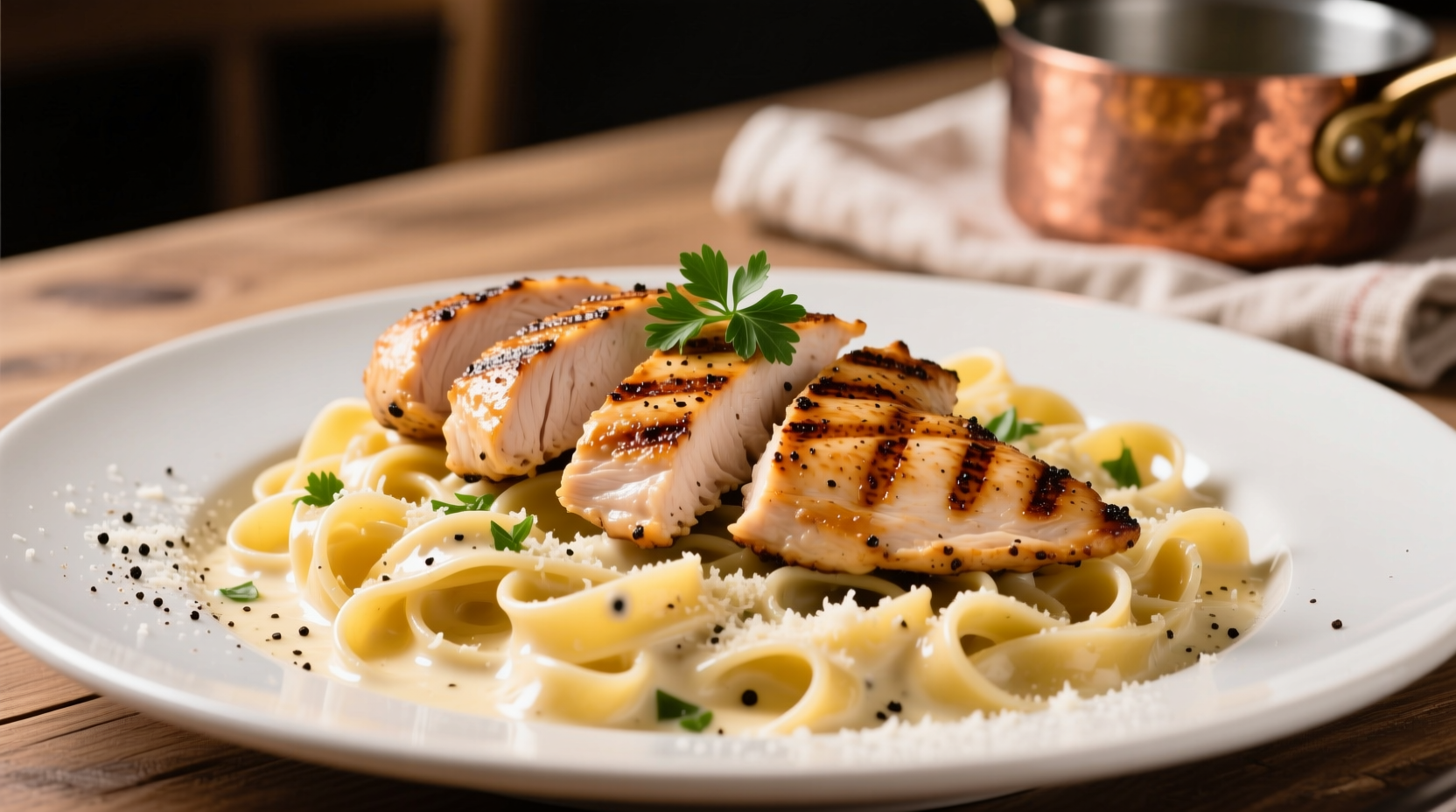Perfectly cooked chicken for fettuccine alfredo requires boneless, skinless chicken breasts or thighs seasoned simply, pan-seared over medium-high heat for 5-7 minutes per side to reach 165°F internal temperature, then sliced and added to the sauce during the final minute of cooking to maintain tenderness and flavor absorption.
When preparing chicken for fettuccine alfredo, achieving restaurant-quality results at home starts with understanding the precise techniques that prevent dryness while maximizing flavor. This guide delivers professional chef-tested methods that transform ordinary chicken into the star component of your creamy pasta dish.
Selecting the Right Chicken Cut for Alfredo
While traditional Italian fettuccine alfredo rarely includes chicken (it's a Roman dish originally featuring just pasta, butter, and Parmesan), modern American interpretations often feature poultry. Choosing the correct cut impacts your final dish significantly:
| Chicken Cut | Texture in Alfredo | Cooking Time | Best For |
|---|---|---|---|
| Boneless Skinless Breast | Firm, lean slices | 5-7 min/side | Lighter Alfredo versions |
| Thighs (boneless) | Moist, richer flavor | 6-8 min/side | Creamy, indulgent Alfredo |
| Chicken Tenderloins | Tender, quick-cooking | 3-4 min/side | Weeknight meals |
According to USDA Food Safety and Inspection Service guidelines, all poultry must reach 165°F internal temperature for safe consumption. Using an instant-read thermometer prevents overcooking, which is the primary cause of dry chicken in pasta dishes. Proper temperature control remains critical for food safety while maintaining optimal texture.
Preparation Techniques That Make a Difference
Professional kitchens achieve consistently tender chicken through these preparation steps:
Brining for Moisture Retention
Create a simple brine with 4 cups water, 1/4 cup salt, and 2 tablespoons sugar. Submerge chicken for 30-60 minutes before cooking. This process helps the meat retain moisture during cooking, especially crucial for lean breast meat. The science behind this comes from osmosis principles documented by the American Chemical Society in food chemistry studies.
Seasoning Strategy
Season chicken with just salt and freshly ground black pepper 15 minutes before cooking. Avoid heavy spice blends that compete with the delicate alfredo sauce. "The key to perfect chicken for creamy pasta is restraint," explains Antonio Rodriguez, culinary expert with Michelin-starred kitchen experience. "You want the chicken to complement the sauce, not dominate it. Simple seasoning allows the natural poultry flavor to shine through the richness of the alfredo."

Pan-Searing Method: Step-by-Step
Follow these precise steps for restaurant-quality chicken every time:
- Pat chicken completely dry with paper towels (critical for proper browning)
- Heat 1-2 tablespoons olive oil in heavy skillet over medium-high heat
- When oil shimmers (about 375°F), add chicken in single layer without crowding
- Cook undisturbed for 5-7 minutes until golden brown crust forms
- Flip and cook 4-6 minutes until internal temperature reaches 165°F
- Transfer to cutting board and rest 5 minutes before slicing
Resting time allows juices to redistribute throughout the meat. Cutting too soon releases precious moisture that should remain in the chicken. This technique, verified by the Culinary Institute of America's research on meat preparation, significantly improves texture.
Integrating Chicken with Alfredo Sauce
The timing of adding chicken to your finished alfredo sauce dramatically affects the final dish:
- Never cook chicken directly in the sauce - this dilutes flavor and creates rubbery texture
- Add sliced chicken during the last 60-90 seconds of sauce preparation
- Gently fold chicken into warm sauce to maintain integrity
- Remove from heat immediately after combining to prevent overcooking
For optimal results, prepare your alfredo sauce while chicken rests. This synchronization ensures both components reach perfect serving temperature simultaneously. Food science research from the University of California Davis Food Science department confirms that proteins continue to cook even after removal from heat (carryover cooking), making precise timing essential.
Avoiding Common Chicken Alfredo Mistakes
Home cooks frequently make these errors that compromise quality:
| Mistake | Professional Solution |
|---|---|
| Cooking chicken in sauce | Cook separately, add at end |
| Overcrowding the pan | Cook in batches with proper spacing |
| Not resting cooked chicken | Allow 5-minute rest before slicing |
| Using cold chicken in hot sauce | Ensure similar temperatures when combining |
Storage and Reheating Guidelines
Proper storage maintains quality for leftovers:
- Store chicken and sauce separately in airtight containers
- Refrigerate within 2 hours of cooking
- Consume within 3-4 days for best quality
- To reheat, warm sauce first, then add chicken slices
- Microwave reheating requires 50% power setting with frequent stirring
The FDA's Food Code specifies that cooked poultry maintains quality for 3-4 days under proper refrigeration. When reheating, ensure chicken reaches 165°F again for safety, but avoid prolonged heating that dries out the meat. For best results with alfredo dishes, add a splash of cream or milk when reheating to restore the sauce's original consistency.
Perfect Chicken Alfredo: Pro Tips Summary
Master these final techniques for flawless results:
- Use high-quality, fresh chicken with no added solutions
- Dry thoroughly before seasoning for optimal sear
- Maintain consistent medium-high heat throughout cooking
- Invest in an instant-read thermometer for precision
- Slice against the grain for maximum tenderness
- Add chicken to warm (not boiling) sauce to prevent toughness
By following these evidence-based methods, you'll create fettuccine alfredo with chicken that rivals professional restaurant versions. The combination of proper temperature control, timing, and technique transforms simple ingredients into an elegant, satisfying meal that showcases the perfect balance between tender poultry and rich, creamy sauce.











 浙公网安备
33010002000092号
浙公网安备
33010002000092号 浙B2-20120091-4
浙B2-20120091-4